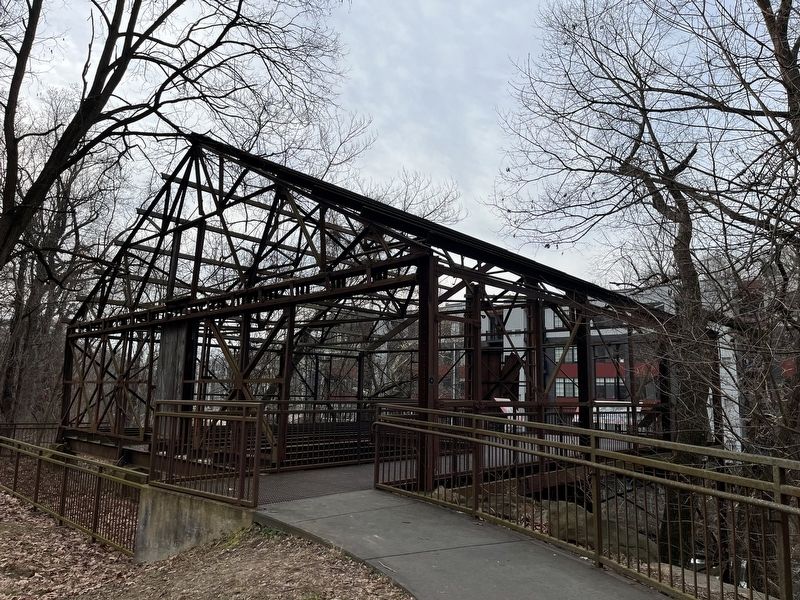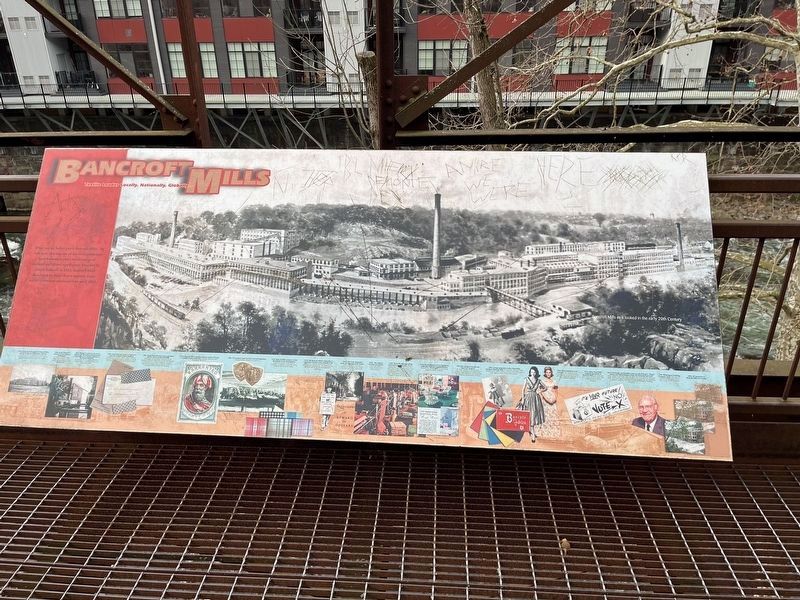Alapocas Run State Park near Wilmington in New Castle County, Delaware — The American Northeast (Mid-Atlantic)
Bancroft Mills
Textile Leader Locally, Nationally, Globally…
What you see before you is Bancroft Mills. At one time, this was one of the most important local businesses and a textile center of national and global significance. Founded by Joseph Bancroft in 1831, Bancroft Mills flourished for more than a century. Later textile operations continued here until 2003.
[Timeline:]
1824: Joseph Bancroft, founder of Bancroft Mills, joins his family near Wilmington, Delaware.
He had remained in England to complete his apprenticeship to a cotton manufacturer when his family moved to America three years earlier.
1826: Joseph Bancroft is hired by a cotton mill near Wilmington.
In 1829, he marries Sarah Poole, who is related to the locally important Shipley and Tatnall families.
1831: Wanting to open his own cotton mill, Joseph Bancroft purchases land and water rights to an old grist mill here on the Brandywine River.
He converts this to a textile mill where cotton is spun, carded into thread, and woven into cloth.
1851: Joseph Bancroft returns to England to learn new methods of fabric finishing.
During the Civil War (1861-1865), his mill becomes the largest producer of fabrics for book cover and window shades in the United States.
1865: Joseph Bancroft enters into an agreement with his sons to run Bancroft Mills.
This begins an era of great expansion for the company. Bancroft Mills teams up with the Simpson Company to print fabric. Simpson's eventually becomes their largest client. A chemist is hired to develop colorfast dyes for the company.
1876: Bancroft Mills is the first company outside of Europe to produce Turkey Red Cloth, a popular fabric dye used throughout the world.
1889: The company enters the Paris Universal Exposition, winning a bronze medal for its patents.
1916: Bancroft Mills continues to lead the industry in new developments, using rayon (made by the duPont Company) to produce a fabric for use in hospital and restaurant linens.
1922: The Bancroft Athletic Association is organized to further a sense of family at the mill, and to "provide clean healthy exercise." Three hundred people join. The following year, the first issue of The Bancroft Bulletin is published.
1930's: The Great Depression marks the beginning of the decline of Bancroft Mills. Two active members of the family die. Profits are poor each of the years of this decade.
1940: The company develops new finishes that make fabrics water-resistant and flame-resistant.
1942: World War II brings ceiling prices and wage restrictions. Women replace

Photographed By Devry Becker Jones (CC0), February 9, 2024
2. Bancroft Mills Display at Alapocas State Park
1945: The development of new finishes for cloth helps improve company fortunes.
Research and development are becoming important to the company.
1953: The company launches the "Ban-Lon" program.
By 1958, research and development outpace the production of finished cloth. Acquiring other companies and trademarks also dominates the company's activities.
1961: A large competitor, Indian Head Mills, purchases Bancroft Mills. At this time, Bancroft Mills employs over 2,000 workers. Indian Head Mills gains the rights to most of Bancroft's patents.
1964: Plant employees try to unionize. The attempt is not successful, but it marks the worst period of employee relations in the company's history.
1973: Indian Head Mills suspends operations at Bancroft Mills and closes the site. There are fewer than 350 employees left with the company.
1973: Fred Krapf, a local builder, teams up with Richard C. "Kippy" duPont and Clifford Winton to form the Industrial Park Trust.
When Indian Head Mills closes the plant, the trust purchases Bancroft Mills. They keep the mill running to bring in money for the remaining employees' pensions. The site is leased to Wilmington Finishing Company.
1997: Wilmington Finishing Company closes. The space is leased to Wilmington Piece Dye, a very small operation.
2003: All operations at Bancroft Mills have ceased.
Erected by Delaware State Parks.
Topics and series. This historical marker is listed in this topic list: Industry & Commerce. In addition, it is included in the Delaware State Parks series list. A significant historical year for this entry is 1831.
Location. 39° 46.079′ N, 75° 33.498′ W. Marker is near Wilmington, Delaware, in New Castle County. It is in Alapocas Run State Park. Marker is on Northern Delaware Greenway Trail, on the right when traveling south. Touch for map. Marker is at or near this postal address: 6796 Northern Delaware Greenway Trl, Wilmington DE 19803, United States of America. Touch for directions.
Other nearby markers. At least 8 other markers are within walking distance of this marker. A Family Company (here, next to this marker); Joseph Bancroft and His Legacy (a few steps from this marker); The blue rocks of Alapocas Run Park (about 700 feet away, measured in a direct line); Alapocas Run Park (about 700 feet away); Ruth Ann Minner, Governor (approx. 0.2 miles away); Site of Gilpin Mills (approx. ¼ mile away); Wilmington Friends School (approx. 0.3 miles away); Welcome to the Delaware Art Museum Labyrinth (approx. 0.4 miles away). Touch for a list and map of all markers in Wilmington.
Credits. This page was last revised on February 10, 2024. It was originally submitted on February 10, 2024, by Devry Becker Jones of Washington, District of Columbia. This page has been viewed 80 times since then. Photos: 1, 2. submitted on February 10, 2024, by Devry Becker Jones of Washington, District of Columbia.
